- Home
- About Us
- Industry
- Services
- Reading
- Contact Us
Automotive Fire Extinguisher Market: Current Analysis and Forecast (2023-2030)
Emphasis on Agent Type (Chemical-Based, Water-Based, CO2-Based, Metal-Based, Powdered-Based, and Foam-Based.); Vehicle Type (Passenger Vehicles, Heavy Commercial Vehicles (HCV), and Light Commercial Vehicles (LCV)); and Region/Country
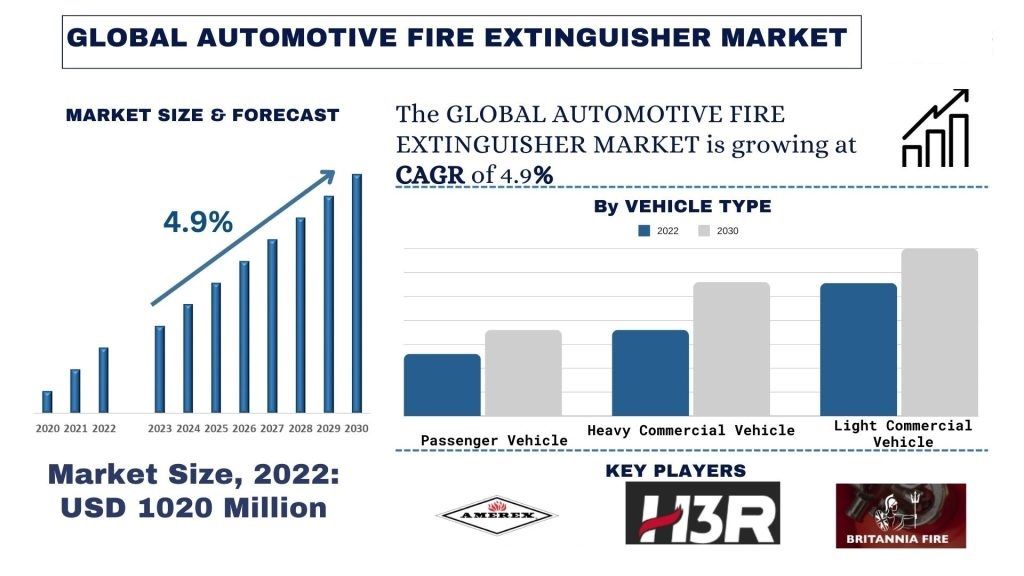
Automotive Fire Extinguisher Market Size & Forecast
The Automotive Fire Extinguisher Market was valued at USD billion in 2022 and is expected to grow at a strong rate of around 4.9% during the forecast period (2023-2030), owing to the growing demand for both passenger as well as commercial vehicles.
Automotive Fire Extinguisher Market Analysis
One of the primary factors contributing to the heightened demand for automotive fire extinguishers is the increasing number of vehicles on the road. With the global automobile industry experiencing unprecedented growth, the likelihood of vehicular accidents and, consequently, fire-related incidents has also risen. According to recent statistics, there were over 1.35 million road traffic deaths worldwide in 2018 alone, underscoring the importance of having adequate safety measures in place. Furthermore, the complexity of modern vehicles, particularly with the integration of advanced technologies and intricate electrical systems, has made them more susceptible to fire hazards. A minor malfunction or a short circuit can quickly escalate into a full-blown fire, posing a significant threat to both passengers and the vehicle itself. As such, automotive fire extinguishers have emerged as a crucial safety tool to mitigate these risks and prevent catastrophic outcomes. Moreover, the growing adoption of electric vehicles has also played a significant role in driving the demand for automotive fire extinguishers. Recent instances of EV fires have further underscored the importance of having proper fire safety equipment readily available. For instance, in 2021, a Tesla Model S caught fire in a residential garage in Pennsylvania, causing extensive damage to the property. These incidents serve as a stark reminder of the potential risks associated with electric vehicle fires and the critical role that fire extinguishers play in containing such emergencies.
Some of the major players operating in the market include Amerex Corporation; H3R Performance, Inc.; Buckeye Fire Equipment Company; Britania Fire Ltd; CEASEFIRE INDUSTRIES PVT LTD; YAMATO PROTEC CORPORATION; HOCHIKI Corporation; Flamestop Australia Pty Ltd; Minimax; and Gielle. Several M&As along with partnerships have been undertaken by these players to facilitate customers with hi-tech and innovative products/technologies.
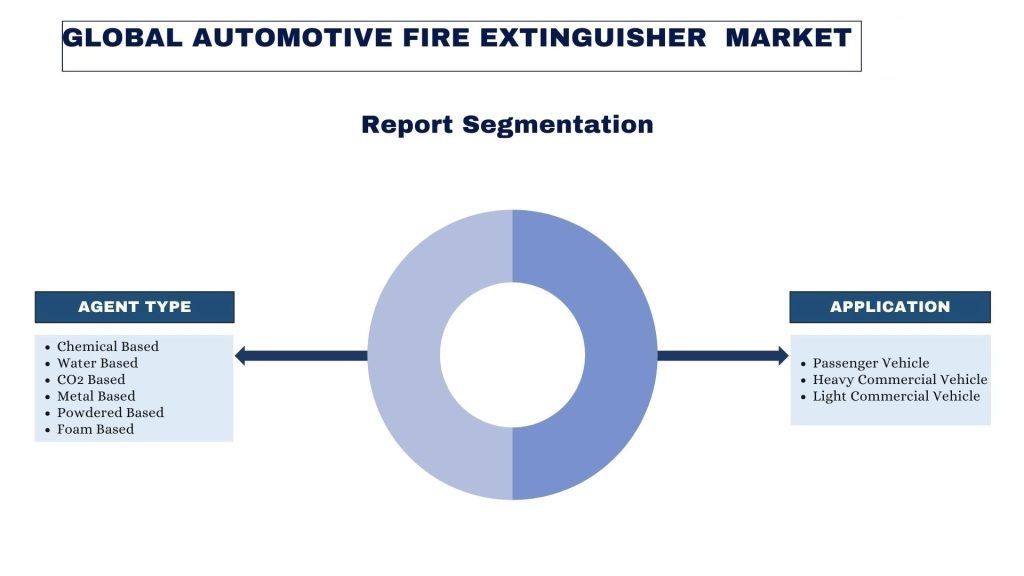
Automotive Fire Extinguisher Market Trends
“Amongst agent type, the dry powder based automotive fire extinguisher segment held the significant market share in terms of value in 2022.”
Based on agent type, the market is categorized into chemical-based, water-based, CO2-based, metal-based, powdered-based, and foam-based. Dry powdered based automotive fire extinguishers hold the majority share of the market. The primary factor that is responsible for its widespread adoption is its effectiveness. Dry powder-based agents are known for their versatility and effectiveness in extinguishing various types of fires, including those fueled by flammable liquids, gases, and electrical equipment. This makes them a popular choice for automotive applications where the source of the fire may vary. Furthermore, dry powder-based agents have a quick suppression capability, allowing them to smother the fire rapidly and prevent it from spreading further. In the case of automotive fires, quick action is crucial to prevent extensive damage to the vehicle and ensure the safety of occupants. Moreover, automotive fire extinguishers need to be portable and easy to handle in emergencies. Dry powder-based agents offer a compact and lightweight solution, making them convenient to store in vehicles without taking up too much space. Factors like these are playing a pivotal role in this remarkable surge in demand for dry powder based automotive fire extinguishers in the market.
“Amongst vehicle type, the light commercial vehicle (LCV) is expected to witness a significant growth during the forecast period (2023-2030).”
Based on vehicle type, the market is segmented into passenger vehicles, heavy commercial vehicles (HCV), and light commercial vehicles (LCV). The light commercial vehicles are expected to experience substantial growth during the predicted time frame. The primary factor responsible for this high growth can be attributed to the remarkable surge in e-commerce activities. The rise of e-commerce platforms has significantly boosted the demand for LCVs as businesses require efficient and reliable transportation for the delivery of goods. Furthermore, with rapid urbanization and infrastructural developments taking place worldwide, the need for versatile and agile transportation solutions has surged. LCVs offer compact and maneuverable options for navigating congested urban areas, making them essential for various commercial activities. Moreover, with a growing emphasis on sustainability and reducing carbon emissions, businesses are increasingly opting for eco-friendly transportation solutions. LCVs, especially electric and hybrid models, align with these environmental goals and offer a cleaner alternative for urban logistics operations. Considering these factors, the sustained high demand for light commercial vehicles is expected to have a ripple effect on the automotive industry, particularly in the realm of safety equipment such as automotive fire extinguishers. As the number of LCVs on the roads increases, the risk of vehicle fires also escalates, highlighting the importance of fire safety measures in commercial fleets.
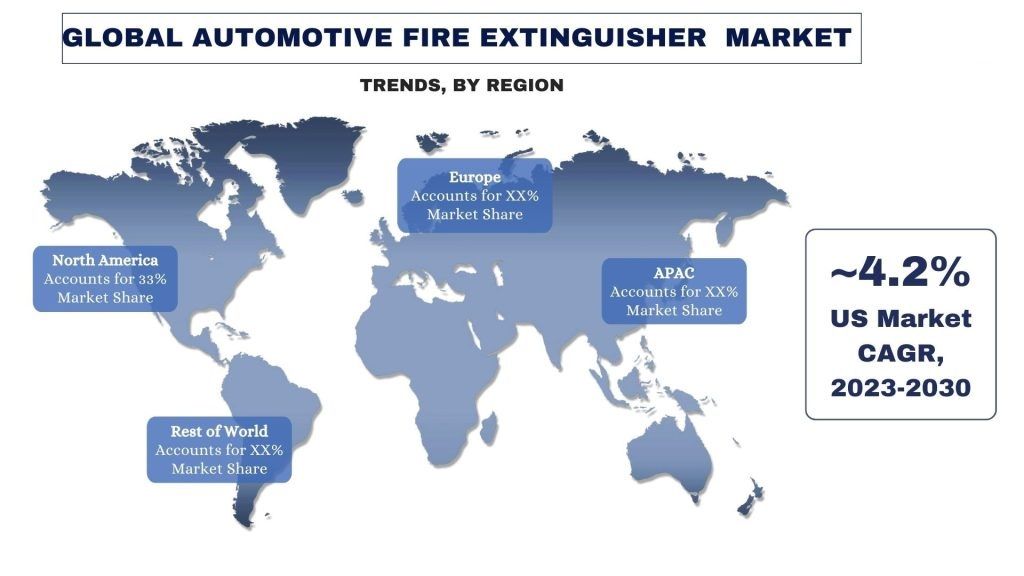
“North America held the significant share of the market in the year 2022.”
North America holds the majority of the market share. The primary factor attributed to this domination is the stringent safety regulations by governments. North America has some of the strictest safety regulations in the automotive industry, driving the demand for safety equipment like fire extinguishers. Organizations such as the National Fire Protection Association (NFPA) and the Occupational Safety and Health Administration (OSHA) have set guidelines that mandate fire safety measures in vehicles. Furthermore, North America has a large number of vehicles on its roads, including personal cars, commercial vehicles, and public transportation. The sheer volume of vehicles increases the risk of fire incidents, leading to a higher demand for fire extinguishers as a safety measure. For instance, data from the U.S. Department of Transportation shows that as of 2021, there were over 276 million registered vehicles in the United States alone, highlighting the need for safety equipment like fire extinguishers. Moreover, the automotive industry in North America is known for its focus on innovation and technology. This translates to the development of advanced fire suppression systems and fire extinguishers specifically designed for vehicles. The presence of cutting-edge technology attracts consumers and businesses looking for reliable safety solutions. Considering these factors the sustained demand for automotive fire extinguishers is expected to exist for a substantial period in North America during the predicted timeframe.
Automotive Fire Extinguisher Market Report Coverage
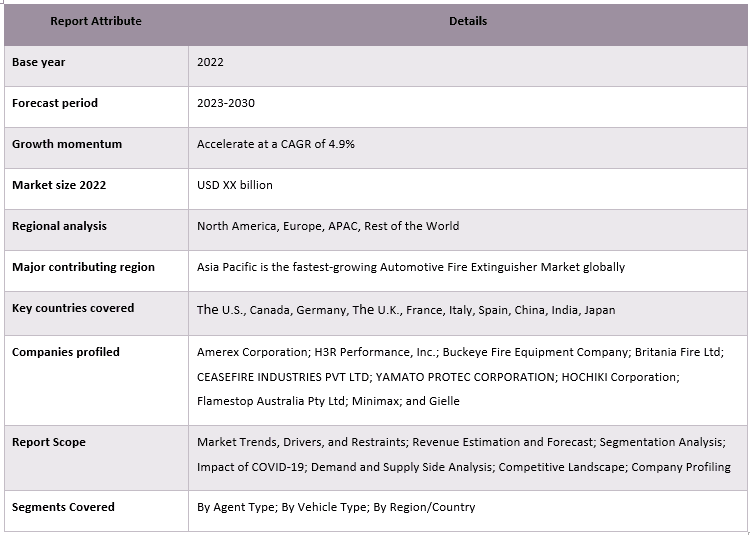
Reasons to buy this report:
- The study includes market sizing and forecasting analysis validated by authenticated key industry experts.
- The report presents a quick review of overall industry performance at one glance.
- The report covers an in-depth analysis of prominent industry peers with a primary focus on key business financials, product portfolios, expansion strategies, and recent developments.
- Detailed examination of drivers, restraints, key trends, and opportunities prevailing in the industry.
- The study comprehensively covers the market across different segments.
- Deep dive regional level analysis of the industry.
Customization Options:
The global Automotive Fire Extinguisher market can further be customized as per the requirement or any other market segment. Besides this, UMI understands that you may have your own business needs, hence feel free to contact us to get a report that completely suits your requirements.
Table of Content
Research Methodology for the Automotive Fire Extinguisher Market Analysis (2023-2030)
Analyzing the historical market, estimating the current market, and forecasting the future market of the global Automotive Fire Extinguisher market were the three major steps undertaken to create and analyze the adoption of Automotive Fire Extinguisher in major regions globally. Exhaustive secondary research was conducted to collect the historical market numbers and estimate the current market size. Secondly, to validate these insights, numerous findings and assumptions were taken into consideration. Moreover, exhaustive primary interviews were also conducted, with industry experts across the value chain of the global Automotive Fire Extinguisher market. Post assumption and validation of market numbers through primary interviews, we employed a top-down/bottom-up approach to forecasting the complete market size. Thereafter, market breakdown and data triangulation methods were adopted to estimate and analyze the market size of segments and sub-segments of the industry pertains to. Detailed methodology is explained below:
Analysis of Historical Market Size
Step 1: In-Depth Study of Secondary Sources:
A detailed secondary study was conducted to obtain the historical market size of the Automotive Fire Extinguisher market through company internal sources such as annual reports & financial statements, performance presentations, press releases, etc., and external sources including journals, news & articles, government publications, competitor publications, sector reports, third-party database, and other credible publications.
Step 2: Market Segmentation:
After obtaining the historical market size of the Automotive Fire Extinguisher market, we conducted a detailed secondary analysis to gather historical market insights and share for different segments & sub-segments for major regions. Major segments are included in the report as agent type and vehicle type. Further country-level analyses were conducted to evaluate the overall adoption of testing models in that region.
Step 3: Factor Analysis:
After acquiring the historical market size of different segments and sub-segments, we conducted a detailed factor analysis to estimate the current market size of the Automotive Fire Extinguisher market. Further, we conducted factor analysis using dependent and independent variables such as agent type and vehicle type of the Automotive Fire Extinguisher market. A thorough analysis was conducted of demand and supply-side scenarios considering top partnerships, mergers and acquisitions, business expansion, and product launches in the Automotive Fire Extinguisher market sector across the globe.
Current Market Size Estimate & Forecast
Current Market Sizing: Based on actionable insights from the above 3 steps, we arrived at the current market size, key players in the global Automotive Fire Extinguisher market, and market shares of the segments. All the required percentage shares split and market breakdowns were determined using the above-mentioned secondary approach and were verified through primary interviews.
Estimation & Forecasting: For market estimation and forecast, weights were assigned to different factors including drivers & trends, restraints, and opportunities available for the stakeholders. After analyzing these factors, relevant forecasting techniques i.e., the top-down/bottom-up approach were applied to arrive at the market forecast for 2030 for different segments and sub-segments across the major markets globally. The research methodology adopted to estimate the market size encompasses:
- The industry’s market size, in terms of revenue (USD) and the adoption rate of the Automotive Fire Extinguisher market across the major markets domestically
- All percentage shares, splits, and breakdowns of market segments and sub-segments
- Key players in the global Automotive Fire Extinguisher market in terms of products offered. Also, the growth strategies adopted by these players to compete in the fast-growing market.
Market Size and Share Validation
Primary Research: In-depth interviews were conducted with the Key Opinion Leaders (KOLs) including Top Level Executives (CXO/VPs, Sales Head, Marketing Head, Operational Head, Regional Head, Country Head, etc.) across major regions. Primary research findings were then summarized, and statistical analysis was performed to prove the stated hypothesis. Inputs from primary research were consolidated with secondary findings, hence turning information into actionable insights.
Split of Primary Participants in Different Regions
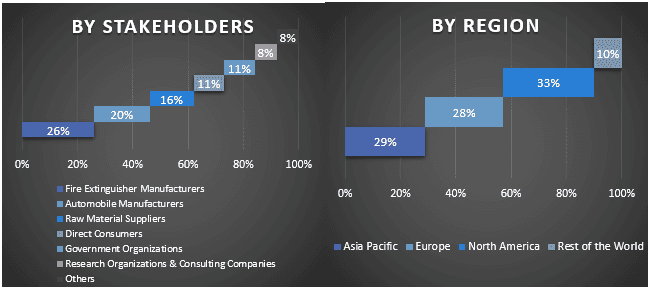
Market Engineering
The data triangulation technique was employed to complete the overall market estimation and to arrive at precise statistical numbers for each segment and sub-segment of the global Automotive Fire Extinguisher market. data was split into several segments & sub-segments after studying various parameters and trends in the areas of purity and application in the global Automotive Fire Extinguisher market.
The main objective of the Global Automotive Fire Extinguisher Market Study
The current & future market trends of the global Automotive Fire Extinguisher market were pinpointed in the study. Investors can gain strategic insights to base their discretion for investments on the qualitative and quantitative analysis performed in the study. Current and future market trends determined the overall attractiveness of the market at a regional level, providing a platform for the industrial participant to exploit the untapped market to benefit from a first-mover advantage. Other quantitative goals of the studies include:
- Analyze the current and forecast market size of the Automotive Fire Extinguisher market in terms of value (USD). Also, analyze the current and forecast market size of different segments and sub-segments.
- Segments in the study include areas of agent type and vehicle type.
- Define and analyze the regulatory framework for the Automotive Fire Extinguisher
- Analyze the value chain involved with the presence of various intermediaries, along with analyzing customer and competitor behaviors of the industry
- Analyze the current and forecast market size of the Automotive Fire Extinguisher market for the major region
- Major countries of regions studied in the report include Asia Pacific, Europe, North America, and the Rest of the World
- Company profiles of the Automotive Fire Extinguisher market and the growth strategies adopted by the market players to sustain in the fast-growing market
- Deep dive regional level analysis of the industry
Frequently Asked Questions FAQs
Q1: What is the current market size and growth potential of the global Automotive Fire Extinguisher market?
Q2: What are the driving factors for the growth of the global Automotive Fire Extinguisher Market?
Q3: Which segment has the largest share of the global Automotive Fire Extinguisher market by functionalities?
Q4: What are the emerging technologies and trends in the global Automotive Fire Extinguisher market?
Q5: Which region will be the fastest-growing global Automotive Fire Extinguisher market?
Q6: Who are the key players in the global Automotive Fire Extinguisher market?
Related Reports
Customers who bought this item also bought










